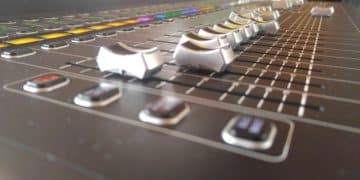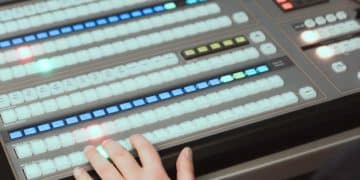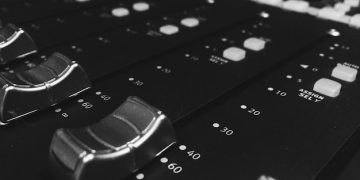Mixing for Headphones: Achieve Pro-Level Accuracy
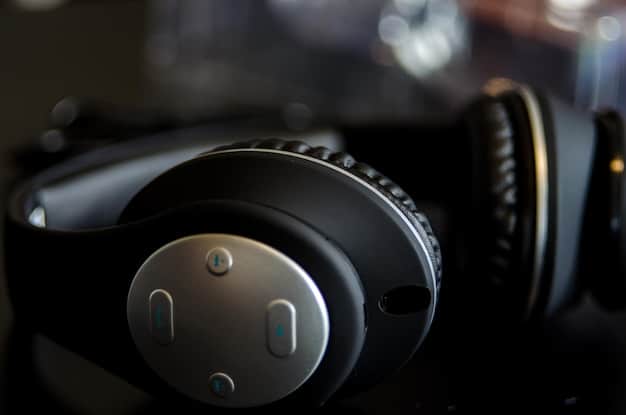
Mixing for headphones can be tricky, but with the right techniques and understanding of their limitations, you can achieve accurate and professional-sounding mixes that translate well to other playback systems.
Mixing music on headphones presents unique challenges compared to using studio monitors. However, with the right knowledge and techniques, you can achieve professional-quality mixes that sound great on any playback system. Ready to unlock the secrets of mixing for headphones?
Understanding the Challenges of Mixing on Headphones
Mixing on headphones can seem like a convenient alternative to using studio monitors, especially for those working in small spaces or on the go. However, headphones present several unique challenges that can impact the accuracy and translation of your mixes. Let’s explore some of the key issues.
One of the main challenges is the lack of natural crossfeed that occurs when listening to speakers. With speakers, sound from the left speaker reaches both ears, and vice versa, creating a sense of space and width. Headphones, on the other hand, deliver sound directly to each ear, resulting in a wider stereo image that can be misleading.

The Importance of Crossfeed
Crossfeed is a crucial element in creating a natural and balanced stereo image. It helps to prevent the extreme left-right separation that can occur when mixing on headphones, which can lead to mixes that sound unnatural or disorienting on other playback systems.
Headphone Frequency Response
Headphones often have a different frequency response than studio monitors, which can also skew your perception of the mix. Some headphones may exaggerate certain frequencies, such as the bass or treble, while others may have dips or peaks in their response. It’s essential to be aware of your headphones’ frequency response and how it might be affecting your mixing decisions.
- Understand your headphones’ frequency response through frequency chart analysis.
- Use reference mixes to compare your mixes on your headphones.
- Employ EQ to compensate for frequency imbalances in your headphones.
Addressing these challenges is crucial for achieving accurate mixes on headphones. By understanding the limitations of headphones and using the right techniques, you can create mixes that translate well to other playback systems and sound great on any device. Make sure your end result for mixing for headphones will always benefit your tracks.
Choosing the Right Headphones for Mixing
Selecting the right headphones is a critical first step in achieving accurate mixes. Not all headphones are created equal, and some are better suited for mixing than others. Here are some key factors to consider when choosing headphones for mixing.
Look for headphones with a flat frequency response. This means that the headphones reproduce all frequencies accurately, without exaggerating or attenuating any particular frequency range. Flat frequency response headphones provide a more accurate representation of the mix and help you make better mixing decisions.
Open-Back vs. Closed-Back Headphones
Open-back headphones have an open design that allows sound to escape, while closed-back headphones have a sealed design that isolates sound. Open-back headphones typically offer a wider and more natural soundstage, but they also allow more sound to bleed in and out, which may not be ideal for noisy environments. Closed-back headphones, on the other hand, offer better isolation but may have a more constricted soundstage.
Comfort and Fit
Comfort is another important factor to consider, especially if you plan to spend long hours mixing on headphones. Look for headphones with comfortable earcups and a lightweight design that won’t cause fatigue or discomfort. The fit should also be snug enough to provide adequate isolation but not so tight that it causes pressure or pain.
- Evaluate frequency response, aiming for flat or neutral.
- Consider open-back headphones for accurate stereo imaging.
- Ensure comfort for long mixing sessions.
Choosing the right headphones is a personal decision, and it’s essential to try out different models to find the ones that work best for you. Don’t be afraid to invest in a good pair of headphones, as they can make a significant difference in the quality of your mixes.
Implementing Crossfeed Techniques
As mentioned earlier, the lack of natural crossfeed is one of the main challenges of mixing on headphones. Fortunately, there are several techniques you can use to compensate for this and create a more natural and balanced stereo image.
One common technique is to use a crossfeed plugin. Crossfeed plugins simulate the natural crossfeed that occurs when listening to speakers by blending the left and right channels. This helps to reduce the extreme left-right separation and create a sense of space and width.
Using Crossfeed Plugins
There are many crossfeed plugins available, both free and paid. Some popular options include Goodhertz CanOpener Studio, Waves Nx, and ToneBoosters Isone. These plugins typically offer adjustable crossfeed settings, allowing you to fine-tune the amount of crossfeed to your liking.
Panning Techniques
Panning techniques can also be used to create a more natural stereo image on headphones. Try to avoid panning elements hard left or right, as this can create an unnatural and disorienting effect. Instead, pan elements more subtly, with a slight bias to one side or the other.
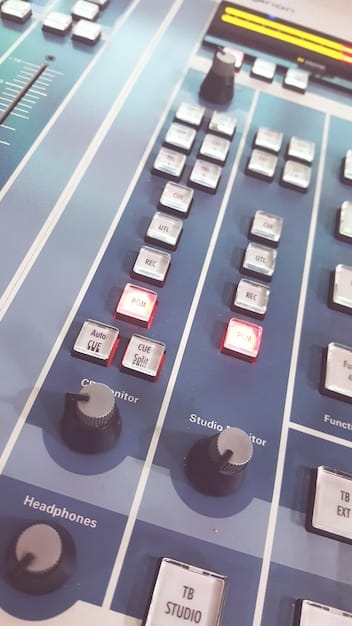
- Utilize crossfeed plugins to simulate natural crossfeed.
- Experiment with the panning of your sounds to get the crossfeed right.
- Test mixing with different width settings to find what’s right for you.
By implementing crossfeed techniques, you can overcome the limitations of mixing on headphones and achieve a more natural and balanced stereo image. This will help your mixes translate better to other playback systems and sound great on any device. Ensure your mixing for headphones considers implementation of the crossfeed.
Utilizing Reference Tracks
Reference tracks are essential tools for any mixing engineer, regardless of whether they are working on speakers or headphones. Reference tracks are commercially released songs that you admire and that serve as a benchmark for your own mixes. By comparing your mix to a reference track, you can identify areas where your mix may be lacking or overemphasized.
When choosing reference tracks, select songs that are similar in style and instrumentation to the song you are mixing. This will allow you to make more direct comparisons and identify specific areas where your mix may need improvement.
Comparing Frequency Balance
One of the most important things to compare is the frequency balance. Listen to the reference track and pay attention to the overall tonal balance. Is the bass too loud or too quiet? Are the mids clear and present? Is the high end smooth and airy? Compare these characteristics to your own mix and make adjustments as needed.
Comparing Stereo Width
Also, compare the stereo width of your mix to the reference track. Is your mix too wide or too narrow? Are the elements in the stereo image clearly defined and positioned? Use panning and stereo widening techniques to match the stereo width of your reference track.
- Choose reference tracks with similar style and instrumentation.
- Frequently compare the bass, mids, and highs between the tracks.
- Set the playback volume equal for both tracks while referencing.
Using reference tracks is a valuable technique for ensuring that your mixes are balanced, clear, and translate well to other playback systems.
Addressing Low-End Frequencies on Headphones
Mixing low-end frequencies on headphones can be particularly challenging. Headphones often struggle to reproduce low frequencies accurately, which can make it difficult to make informed decisions about the bass and sub-bass in your mix.
One way to address this is to use a dedicated sub-bass monitoring system. This could be a subwoofer or a pair of bass-heavy headphones that are designed to reproduce low frequencies accurately.
Using a Subwoofer
If possible, it’s helpful to use a subwoofer in conjunction with your headphones. This will allow you to hear the low frequencies more accurately and make better decisions about the bass and sub-bass in your mix. Be sure to calibrate your subwoofer to your headphones so that the overall frequency balance is consistent.
Being aware of Headphone limitations
Even with a subwoofer, it’s essential to be aware of your headphones’ limitations when mixing low-end frequencies. Some headphones may roll off the low end, while others may exaggerate it. Use your ears and your reference tracks to guide your decisions, and don’t be afraid to make small adjustments until you achieve a balanced and natural sound.
- Be conscious of headphone limitations in the low end.
- Use an EQ to filter unnecessary sub-bass content.
- Experiment with compression to glue the low-end together.
By implementing these techniques, you can overcome the challenges of mixing low-end frequencies on headphones and achieve a balanced and impactful bass response in your mixes.
Taking Breaks and A/B Testing
Mixing can be fatiguing, especially when working on headphones. It’s important to take regular breaks to rest your ears and avoid making mistakes due to ear fatigue. A good rule of thumb is to take a 15-minute break every hour or two.
In addition to taking breaks, it’s also helpful to A/B test your mix on different playback systems. This means listening to your mix on different sets of headphones, speakers, and devices to see how it translates. If your mix sounds good on a variety of playback systems, then you can be confident that it will translate well to a wider audience.
The Importance of Fresh Ears
Taking breaks allows you to come back to your mix with fresh ears, which can help you identify subtle issues that you may have missed before. It’s also helpful to listen to your mix in different environments, such as in your car or on your phone, to get a better sense of how it will sound to listeners.
Checking on Different Systems
A/B testing your mix on different playback systems is a crucial step in ensuring that it translates well to a wider audience. If your mix sounds good on a variety of headphones, speakers, and devices, then you can be confident that it will sound great on any playback system. Therefore, A/B testing should be crucial when mixing for headphones
- Take regular breaks during longer mixing sessions.
- A/B test to know how your mix translates.
- Listen to your mix on multiple devices.
By taking breaks and A/B testing your mix, you can avoid ear fatigue and ensure that your mix sounds great on any playback system.
| Key Point | Brief Description |
|---|---|
| 🎧 Headphone Choice | Opt for flat frequency response headphones. |
| 🎚️ Crossfeed | Use crossfeed plugins for natural stereo imaging. |
| 🎵 Reference Tracks | Compare your mix with similar commercially released tracks. |
| 👂 Breaks & Testing | Take breaks and test output on various devices. |
FAQ
▼
Headphones lack the natural crossfeed of speakers, causing exaggerated stereo separation. Their unique frequency responses can also skew your perception of the mix.
▼
Headphones with a flat frequency response are ideal. Open-back headphones offer a wider soundstage, though closed-back provides better isolation.
▼
Use crossfeed plugins to simulate the natural crossfeed of speakers. Adjust panning subtly to avoid extremes and create a wider feeling.
▼
Reference tracks provide a benchmark for your mixes. Compare your mix to similar professionally released tracks to identify imbalances and issues, fixing those errors and fine-tuning overall quality.
▼
Take frequent breaks, about 15 minutes every hour or two, to avoid ear fatigue. Return to your mix with fresh ears to make better decisions.
Conclusion
Mixing on headphones can be a viable option for music producers, especially those working in less-than-ideal environments. By understanding the challenges, choosing the right headphones, implementing crossfeed techniques, utilizing reference tracks, and taking breaks, you can achieve accurate and professional-sounding mixes that translate well to other playback systems. Take your time and be patient, and your skills in mixing for headphones will evolve.
